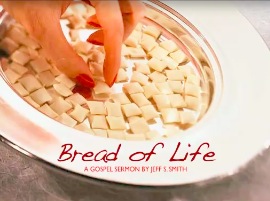Bread of Life
 Tuesday, August 24, 2010 at 9:51AM
Tuesday, August 24, 2010 at 9:51AM  Jesus never backed down, even when his disciples warned him that he was offending the religious leaders in Jerusalem and provoking their wrath, whether by healing on the Sabbath or calling them a brood of vipers or blind guides. Truly, some of the things that Jesus taught are hard on modern ears as well, even for believers, for turning the other cheek and surrendering your coat are challenging requirements. It was his teaching on the Bread of Life, however, that almost instantly turned away a throng of disciples who just could not handle the truth.
Jesus never backed down, even when his disciples warned him that he was offending the religious leaders in Jerusalem and provoking their wrath, whether by healing on the Sabbath or calling them a brood of vipers or blind guides. Truly, some of the things that Jesus taught are hard on modern ears as well, even for believers, for turning the other cheek and surrendering your coat are challenging requirements. It was his teaching on the Bread of Life, however, that almost instantly turned away a throng of disciples who just could not handle the truth.
I. The Context
A. Galilean Manna
1. before bread could be a metaphor for anything, it had to take a literal turn in the hunger of the people thronging about Jesus to hear him speak (John 6:1-14)
2. barley was the bread of the common man, the rich preferred wheat and the fish were probably dried or pickled, but clearly five loaves and two fishes would not be enough when it would take an estimated eight months’ wages to fund a meal sufficient for the crowd
3. Jesus, however, was teaching even as he was working his wonders upon such meager rations – he was teaching when he offered thanks for so little and when he distributed to the diners and when he urged them to gather up the leftovers; Jesus was teaching them about the power of God in a lesson that transcended a single meal or the wonder of seeing the impossible done before your eyes
a. signs and wonders were about more than the spectacle; they were designed to confirm the divinity of the message behind them (Mark 16:17-20)
b. only those whose bellies hungered more than their spirits could miss the truer significance of the wonders, but most did
B. Hungry Again
1. naturally, their spirits remained emaciated and their bellies hungered again in due time (John 6:22-26)
2. Jesus promised the Samaritan woman at the well living water superior to whatever she could draw out of the ground time after time and now he offered the same sustenance for the spirits of this group, if only they could see it and accept it over the pangs of their stomachs (John 6:27-34)
3. they went so far as to remind Jesus about the story of Moses and how manna fell from the sky upon the Israelites’ plates during the Exodus; that is what these disciples wanted – free food to fall from the sky that they could collect day after day without having to do anything harder than believing it
C. Bread of Life
1. and so Jesus encouraged them instead to seek the bread of life, to seek him in whom resurrection and eternal life could be assured (John 6:35-40)
2. but their bellies were still talking to them, deafening their spirits and blinding their hearts so that they could see nothing beyond the next free lunch (John 6:47-50)
3. his speech, however, was still too much like a parable to them; while they did not understand its deeper significance, neither did they comprehend that their exclusion from understanding was an indictment of their sincerity and spirituality (Matthew 13:10-17)
D. This Is a Hard Saying
1. when he spoke plainly, if a little metaphorically still, they were openly disgusted, confused and repulsed at what he suggested (John 6:51)
a. Jesus was again prophesying his crucifixion and the sacrifice of his flesh for the life of the world; as unusual as that was, the invitation to eat his flesh and drink his blood was without much precedent
b. in an exclamatory and climactic way, Jesus was fulfilling what the Law had always said about man’s appetite (Matthew 4:1-4)
2. no other rabbi would make such a claim upon his disciples’ loyalties or use such bitter language and an audience that was really just interested in a little more fish and barley had had just about enough enigmatic symbolism (John 6:52-58)
a. even his last ditch effort to explain it to them in a way that might appeal to their consciences went nowhere (John 6:60-66)
b. Jesus was left with twelve listeners that day, and even one of them was less interested in his flesh and blood than the pound of flesh he was exacting from the treasury bag whenever no one was looking
3. we find that many are choosing their soul’s earthly refuge by what it can do for their flesh, whether it is a meal or a recreational opportunity or the right kind of social experience
a. where Jesus was unwilling to give the masses anything they want to hold onto their bodies, churches today are only too happy to oblige
b. the real answer, however, is in the depth of meaning in his blood and flesh, something more than mere belief, church membership or ritual observance
II. The Meaning
A. Symbolism
1. generally, we refer to this discussion as one rich in symbolism and surely that is so
2. the practice of eating human flesh, after all, amounts to cannibalism and drinking blood was condemned among God’s people under both covenants (see Genesis 9:4, Leviticus 3:17, Acts 15:20-29)
3. just as clearly, Jesus indicates that his flesh and blood are emblems of the crucifixion soon to be accomplished at Jerusalem, but his body would provide the atoning sacrifice of the sins of the world (Hebrews 9:11-22)
4. that body and blood became the propitiation for our sins (Hebrews 10:1-14)
B. Lord’s Supper
1. we remark upon this often when we gather to participate in the Lord’s Supper, a meal with little nutritional value and no potential to fill even the tiniest of stomachs, but one which surely can fill the spirit of the patient, contemplative worshiper (Matthew 26:26-29)
2. the inspired writer of the First Corinthian letter further explained the spiritual significance of sharing in those symbols (First Corinthians 10:15-17, 11:26-32)
3. we speak of the bread as symbolic of his flesh and the wine as symbolic of his blood, even if he was much bolder in asserting the requirement that one eat his flesh and drink his blood
a. in fact, many there misunderstood him because they took him literally, being consumed with the animal drive to obtain food and devoid of the spiritual quest for insight (Romans 8:3-8)
b. only when you understand that the savior and his church aren’t there to fill your stomach, but your spirit, can you begin to see the significance of the cross
C. Transubstantiation
1 the literalists in this passage find modern solace in the Catholic doctrine of Transubstantiation, a second millennium development that holds that the bread and wine upon the table substantively are changed by prayer into literal flesh and blood, which are then consumed by the worshiper as such
2. that, however, is little different from the reaction of the original audience who could not envision the cross, the tomb, or the resurrection
3. transubstantiation reduces the teaching to fleshly act, which can be accomplished without thought or consideration or lingering effect, and that does not harmonize with the context at all
D. Real Discipleship
1. what Jesus hoped to communicate was something deeper than mere symbols and something that would extend further than a weekly act of public reverence, something that was spiritually discerned and not consumed and eliminated through bodily function
2. eating the Lord’s flesh and drinking his blood is emblematic of comprehensive, submissive discipleship, the kind that accepts what offends the unbeliever and the shallow (First Corinthians 5:7-8)
3. just as Ezekiel and the apostle John were instructed to eat a scroll to illustrate the process of taking information into one’s very soul, so we are bound to ingest every word that proceeds from the mouth of God in a way that does more than satisfy a religious impulse (see First Corinthians 1:30)
4. it is a process of sanctification that draws us deeper into the cause and character of Christ; “It is no longer I who live, but Christ who lives in me. And the life I now live in the flesh I live by faith in the Son of God, who loved me and gave himself for me” (Galatians 2:20).
Conclusion
We can never be saved unless we become comfortable with the idea of eating Christ’s flesh and drinking his blood, not literally or transubstantiationally, but also not merely through symbols and rituals. Our success in faith depends upon a willingness to feed upon him by taking his will and character deep into our hearts where it can mold us and make us useful to him.
Questions For Review
- Why did Jesus heal the sick and feed the hungry?
- What is the church’s role in feeding the poor and healing the sick?
- What was manna? What point did the hungry make with it in John 6?
- Why did Jesus teach with parables?
- What was a hard saying to the John 6 audience? Why was it hard?
- Where is the symbolism in the Lord’s Supper?
- What is Transubstantiation?
 Jeff Smith
Jeff Smith


